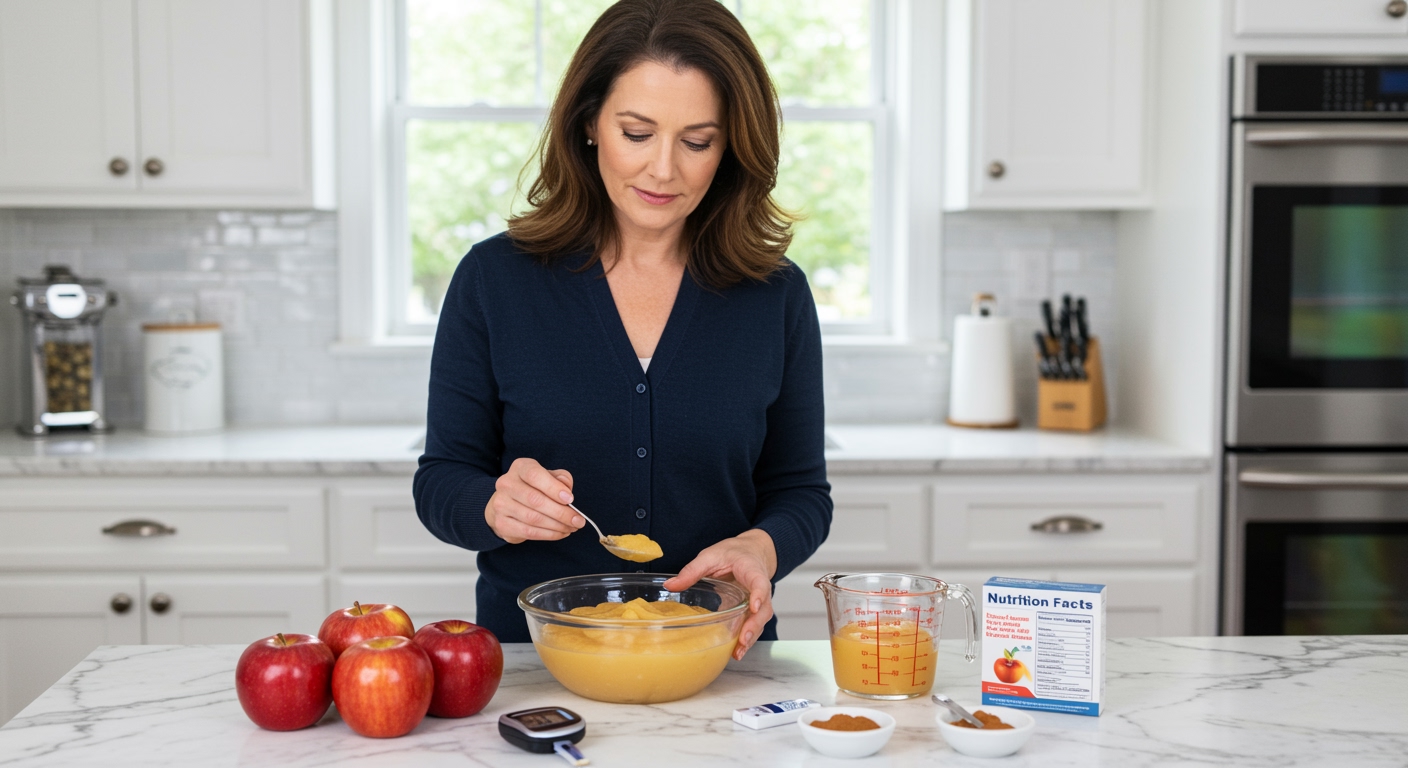✪ Key Takeaway: Unsweetened applesauce can be part of a diabetic diet when consumed in small portions and paired with protein or healthy fats.
Introduction
You walk down the grocery aisle and spot that familiar jar of unsweetened applesauce.
Your mind races with questions about whether this childhood favorite can fit into your diabetic meal plan without sending your blood sugar through the roof.
Hi, I am Abdur, your nutrition coach and today I am going to explain exactly how unsweetened applesauce affects your blood sugar and whether it deserves a place in your diabetes-friendly kitchen.
What Makes Unsweetened Applesauce Different From Regular Versions?
Unsweetened applesauce contains only cooked apples and sometimes a small amount of water or ascorbic acid for preservation.
Regular applesauce often includes added sugars like high fructose corn syrup, cane sugar, or artificial sweeteners that can dramatically spike your blood glucose levels.
The cooking process breaks down the apple fibers, making the natural sugars more readily available for absorption compared to eating a whole apple.
This means your body processes the carbohydrates faster, leading to a quicker rise in blood sugar than you might experience with fresh fruit.
One half-cup serving of unsweetened applesauce contains approximately 14 grams of carbohydrates and 52 calories.
The glycemic index of unsweetened applesauce ranges from 35 to 38, which falls into the low to moderate category for blood sugar impact.
✪ Fact: Processing apples into sauce removes most of the beneficial fiber that helps slow sugar absorption.
How Does Your Body Process Applesauce Carbohydrates?
When you eat unsweetened applesauce, your digestive system quickly breaks down the natural fructose and glucose present in the cooked apples.
Your small intestine absorbs these sugars rapidly because the cooking process has already partially broken down the cellular structure.
This leads to a faster entry of glucose into your bloodstream compared to eating a whole apple with intact fiber.
Your pancreas responds by releasing insulin to help move the glucose from your blood into your cells for energy.
If you have diabetes, your body either does not produce enough insulin or cannot use it effectively, causing blood sugar levels to remain elevated longer than normal.
The peak blood sugar response typically occurs within 30 to 60 minutes after consuming applesauce, making timing important for blood glucose monitoring.
✪ Pro Tip: Test your blood sugar 2 hours after eating applesauce to understand your individual response pattern.
What Portion Size Works Best For Blood Sugar Control?
A safe starting portion for most diabetics is one-quarter cup of unsweetened applesauce, which contains about 7 grams of carbohydrates.
This smaller serving allows you to enjoy the taste while minimizing the impact on your blood glucose levels.
You can gradually increase to a half-cup serving if your blood sugar remains stable, but monitor your individual response carefully.
Pairing applesauce with protein sources like Greek yogurt or a small handful of nuts can help slow the absorption of sugars.
The protein and healthy fats create a more balanced meal that prevents rapid spikes in blood glucose.
Timing also matters – consuming applesauce as part of a meal rather than as an isolated snack provides better blood sugar control.
✪ Note: Your carbohydrate tolerance may vary based on your medication, activity level, and overall diabetes management.
Are There Better Alternatives For Diabetic Snacking?
Fresh apples with the skin intact provide more dietary fiber and create a slower, more controlled blood sugar response than applesauce.
The fiber in whole apples helps slow digestion and provides a feeling of fullness that processed applesauce cannot match.
Other diabetes-friendly fruit options include berries, which are naturally lower in sugar and higher in antioxidants than processed apple products.
If you prefer the convenience of prepared foods, consider making your own applesauce at home using less cooking time to preserve more fiber.
Adding cinnamon to homemade applesauce may provide additional benefits, as some studies suggest cinnamon can help improve insulin sensitivity.
Vegetable-based snacks like cucumber slices, cherry tomatoes, or bell pepper strips offer satisfying crunch without significant carbohydrate content.
✪ Pro Tip: Keep a food diary to track which snacks work best for your blood sugar patterns and energy levels.
The Bottom Line
Unsweetened applesauce can be enjoyed by diabetics when consumed mindfully in appropriate portions and combined with other nutrients that slow sugar absorption.
Smart food choices are not about complete restriction but about understanding how different foods affect your unique body and blood sugar patterns.
I would love to hear about your experience with applesauce and diabetes management, so please share your thoughts, questions, or personal strategies in the comments below.
References
At NutritionCrown, we use quality and credible sources to ensure our content is accurate and trustworthy. Below are the sources referenced in creating this article:
- Natural Smart Health: Is Unsweetened Apple Sauce Good for Diabetics
- Glycemic Index: Applesauce Unsweetened Glycemic Index
- North Coast Organic: Is Apple Sauce Healthy for Me
- Low Carb Check: Applesauce Unsweetened Nutrition Facts





